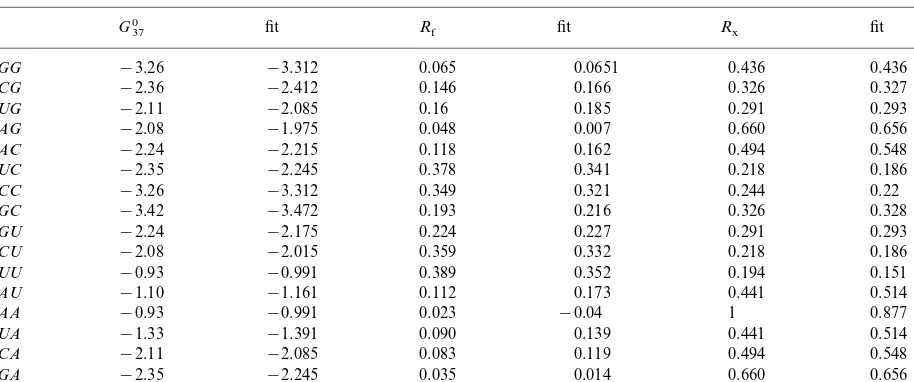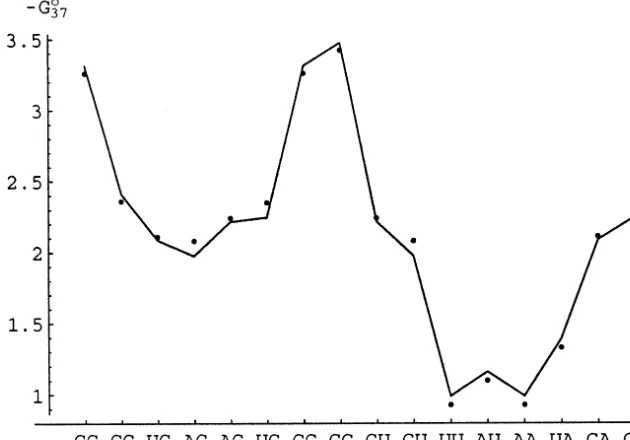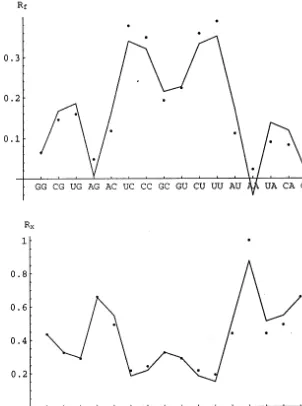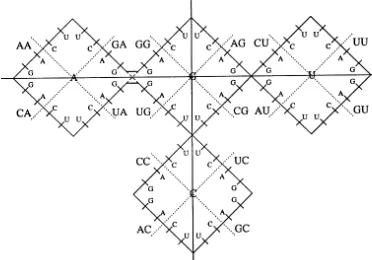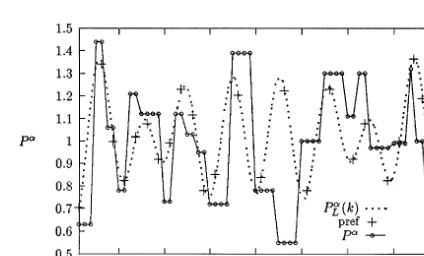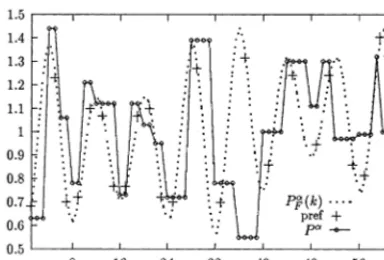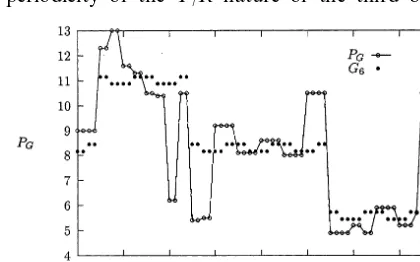The genetic code as a periodic table: algebraic aspects
J.D. Bashford
a, P.D. Jarvis
b,*
aCentre for the Structure of Subatomic Matter,Uni6ersity of Adelaide,Adelaide,SA5005,Australia bSchool of Mathematics and Physics,Uni6ersity of Tasmania,GPO Box252-21,Hobart,Tas.7001,Australia
Received 19 March 2000; received in revised form 16 August 2000; accepted 18 August 2000
Abstract
The systematics of indices of physico-chemical properties of codons and amino acids across the genetic code are examined. Using a simple numerical labelling scheme for nucleic acid bases, A=(−1,0), C=(0,−1), G=(0,1),
U=(1,0), data can be fitted as low order polynomials of the six coordinates in the 64-dimensional codon weight space. The work confirms and extends the recent studies by Siemion et al. (1995. BioSystems 36, 231 – 238) of the conformational parameters. Fundamental patterns in the data such as codon periodicities, and related harmonics and reflection symmetries, are here associated with the structure of the set of basis monomials chosen for fitting. Results are plotted using the Siemion one-step mutation ring scheme, and variants thereof. The connections between the present work, and recent studies of the genetic code structure using dynamical symmetry algebras, are pointed out. © 2000 Elsevier Science Ireland Ltd. All rights reserved.
Keywords:Physico-chemical properties; Genetic code; Periodicity; Dynamical symmetry algebra
www.elsevier.com/locate/biosystems
1. Introduction and main results
Fundamental understanding of the origin and evolution of the genetic code (Osawa et al., 1992) must be grounded in detailed knowledge of the intimate relationship between the molecular bio-chemistry of protein synthesis, and the retrieval from the nucleic acids of the proteins’ stored design information. However, as pointed out by Lacey and Mullins (1983), although ‘‘the nature of an evolutionary biochemical edifice must reflect
… its constituents, … properties which were im-portant to prebiotic origins may not be of rele-vance to contemporary systems’’. Ever since the final elucidation of the genetic code, this convic-tion has led to many studies of the basic building blocks themselves, the amino acids and the nu-cleic acid bases. Such studies have sought to catalogue and understand the spectrum of physico-chemical characteristics of these molecules, and of their mutual correlations. The present work is a contribution to this programme. Considerations of protein structure point to the fundamental importance of amino acid hy-drophilicity and polarity in determining folding and enzymatic capability, and early work (Volkenstein, 1966; Woese et al., 1966; Grantham,
* Corresponding author.
E-mail address: [email protected] (P.D. Jarvis).
1974) concentrated on these aspects; Weber and Lacey (1978) extended the work to mono- and di-nucleosides. Jungck (1978) concluded from a compilation of more than a dozen properties that correlations between amino acids and their corre-sponding anticodon dinucleosides were strongest on the scale of hydrophobicity/hydrophilicity or of molecular volume/polarity. For a comprehen-sive review see Lacey and Mullins (1983).
Subsequent to this early work, using statistical sequence information, conformational indices of amino acids in protein structure have been added to the data sets (Goodman and Moore, 1977). Recently Siemion (1994a,b) has considered the behaviour of these parameters across the genetic code, and has identified certain periodicities and pseudosymmetries present when the data is plot-ted in a certain rank ordering called ‘one-step mutation rings’, being generated by a hierarchy of cyclic alternation of triplet base letters (Siemion and Stefanowicz, 1992). The highest level in this hierarchy is the alternation of the second base letter, giving three major cycles based on the families U, Cand A, each sharing parts of the G
family. The importance of the second base in relation to amino acid hydrophilicity is in fact well known (Weber and Lacey, 1978; Lacey and Mullins, 1983; Taylor and Coates, 1989), and the existence of three independent correlates of amino acid properties, again associated with the U, C
and A families, has also been statistically estab-lished by principal component analysis (Sjo¨stro¨m and Wo¨ld, 1985).
Given the existence of identifiable patterns in the genetic code in this sense, it is of some interest and potential importance to attempt to describe them more quantitatively. Steps along these lines were taken in 1995 by Siemion et al. (1995). With a linear rank ordering of amino acids according to ‘mutation angle’ pk/32, k=1, …, 64 along the one-step mutation rings, parameter Pa
was rea-sonably approximated by trigonometric functions which captured the essential fluctuations in the data.
The metaphor of a quantity such as the Siemion numberk, allowing the genetic code to be arranged in a way which best reflects its structure, in analogy with elemental atomic number Z and
the chemical periodic table, is an extremely pow-erful one. The present paper takes up this idea, but in a more flexible way which does not rely on a single parameter. Instead, a natural labelling scheme is used which is directly related to the combinatorial fact of the triplet base codon struc-ture of the genetic code, and the four-letter base alphabet. Indeed, any bipartite labelling system which identifies each of the four basesA,C,G,U, extends naturally to a composite labelling for codons, and hence amino acids. We choose for bases two coordinates as A=(−1,0), C=(0,−
1), G=(0,1), U=(1,0), so that codons are la-belled as ordered sextuplets, for example
ACG=(−1,0,0,−1,0,1).
In quantitative terms, any numerical indices of amino acid or codon properties, of physico-chem-ical or biologphysico-chem-ical nature, can then be modelled as some functions of the coordinates of this codon ‘weight space’. Because of other algebraic ap-proaches to the structure of the genetic code, we take polynomial functions (for simplicity, of as low order as possible). This restriction does not at all exclude the possibility of periodicities and as-sociated symmetry patterns in the data. In fact, as each of the six coordinates takes discrete values 0,
91, appropriately chosen monomials can easily reproduce such effects (with coefficients to be fitted which reflect the relative strengths of vari-ous different ‘Fourier’ components). Quite simply, the directness of the linear rank ordering, as given by the Siemion numberk, which suggests Fourier series analysis of the data, is here replaced by a more involved labelling system, but with numeri-cal data modelled as simple polynomial functions. The main results of our analysis are as follows. In Section 2 the labelling scheme for nucleic acid bases is introduced, leading to 4N-dimensional
‘weight spaces’ for length-N RNA strands: in particular, 16-dimensional for N=2, and 64-di-mensional for the sextuplet codon labelling (N=
Table 1
Table of dinucleoside properties and predicted values from fitsa
fit Rf fit Rx fit
G370
−3.312 0.065
GG −3.26 0.0651 0.436 0.436
CG −2.36 −2.412 0.146 0.166 0.326 0.327
UG −2.11 −2.085 0.16 0.185 0.291 0.293
−1.975 0.048 0.007
−2.08 0.660
AG 0.656
−2.24
AC −2.215 0.118 0.162 0.494 0.548
−2.35
UC −2.245 0.378 0.341 0.218 0.186
−3.312 0.349 0.321
−3.26 0.244
CC 0.22
GC −3.42 −3.472 0.193 0.216 0.326 0.328
−2.175 0.224 0.227
−2.24 0.291
GU 0.293
−2.08
CU −2.015 0.359 0.332 0.218 0.186
−0.93
UU −0.991 0.389 0.352 0.194 0.151
−1.161 0.112 0.173
−1.10 0.441
AU 0.514
−0.991 0.023 −0.04
AA −0.93 1 0.877
−1.391 0.090 0.139
−1.33 0.441
UA 0.514
−2.11
CA −2.085 0.083 0.119 0.494 0.548
−2.35
GA −2.245 0.035 0.014 0.660 0.656
aG 37
0: Turner free-energy parameters at 37° in kcal mol−1 (Xia et al., 1998); R
f: dinucleoside monophosphate relative
hydrophilicity (Weber and Lacey, 1978);Rx: dinucleotide relative hydrophobicity (Jungck, 1978).
Only four coordinates are involved for these 16-part data sets (Table 1). Moving in Section 3 on to codon properties as correlated to those of amino acids, Siemion numberkwhich establishes amino acid ranking by mutation angle is briefly reviewed. It is shown that the trigonometric approximation of Siemion et al. (1995) to the Chou – Fasman conformational parameters Pa, Pb (Chou and
Fasman, 1974; Fasman, 1989) is effectively a four-parameter function which allows for periodicities of 32/5, 8, 32/3 and 64 codons. Again, simple basis monomials having the required elements of the symmetry structure ofPaare identified, leading to
a reasonable (four-parameter) fit. Results are dis-played as Siemion mutation-angle plots. Pb
is treated in a similar fashion. The method estab-lished in Sections 2 and 3 is then applied in Section 4 to other amino acid properties, includ-ing relative hydrophilicity (Weber and Lacey, 1978) and Grantham polarity (Grantham, 1974). It is clearly shown that appropriate polynomial functions can be fitted to most of them (amino acid data is summarised in Table 2).
In Section 5 some concluding remarks, and
Table 2
Table of amino acid properties (Pa,b: conformational
parame-ters (Fasman, 1989); PGr: Grantham polarity (Grantham,
1974);Rf: Relative hydrophilicity (Weber and Lacey, 1978)
outlook for further development of these ideas are given. It is emphasised that, while the idiosyncra-cies of real biology make it inappropriate to re-gard this type of approach as anything but approximate, nonetheless there may be some merit in a more rigorous follow up to establish our conclusions in a statistically valid way. This is particularly interesting in view of Appendix A. This gives a brief review of algebraic work based on methods of dynamical symmetries in the analy-sis of the excitation spectra of complex systems (such as atoms, nuclei and molecules), which has recently been proposed to explain the origin and evolution of the genetic code. Specifically, it is shown how the labelling scheme adopted in the paper arises naturally in the context of models, based either on the Lie superalgebra A5,0sl(6/
1), or the Lie algebra B6so(13), or related
semisimple algebras. The origins and nature of the polynomial functions adopted in the paper, and generalisations of these, are also discussed in the algebraic context. The relationship of the present paper to the dynamical symmetry approach is also sketched in Section 5 below.
2. Codon systematics
Ultimately our approach involves a symmetry between the four heterocyclic bases U, C, A, G
commonly occurring in RNA. A logical starting point then, is to consider the physical properties of small RNA molecules. Dinucleosides and dinu-cleotides in particular are relevant in the informa-tional context of the genetic code and anticode, and moreover are the building blocks for larger nucleic acids (NAs). What follows in this section is a numerical study of some properties of NAs consisting of two bases, while in later sections NAs with three bases (i.e. codons and anticodons) are considered in the context of the genetic code as being correlated with properties of amino acids.
As mentioned in the introduction, we give each NA base coordinates in a two-dimensional ‘weight space’, namely A=(−1,0), C=(0,−1),
G=(0,1), U=(1,0) with the axes labelled d, m,
respectively1. Dinucleosides and dinucleotides are
therefore associated with four coordinates (d1,m1,
d2, m2), e.g. AC=(−1,0,0,−1) with subscripts
referring to the first and second base positions. The physical properties of nucleic acids we choose to fit to are the relative hydrophilicities Rf
of the 16 dinucleoside monophosphates as ob-tained by Weber and Lacey (1978), the relative hydrophobicity Rx of dinucleotides as calculated
by Jungck (1978) from the mononucleotide data of Garel et al. (1973), and the 16 canonical (Crick – Watson) base-pair stacking parameters of Xia et al. (1998) used to compute the free heat of formation G37
0
of formation of duplex RNA strands at 37°C.
It should be noted that the dinucleoside quan-tity Rx was computed as the product of
experi-mentally derived Rx values for mononucleotides
under the assumption that this determines the true dinucleotide values to within 95%. A result of this is that Rx is automatically the same for
dinucle-otides 5%-XY-3% and 5%-YX-3%, (naturally the same
holds for molecules with the reverse orientation); thus Rx is at best an approximate symmetry.
The 16 Turner free-energy parameters are a subset of a larger number of empirically deter-mined thermodynamic ‘rules of thumb’ (see Xia et al., 1998; Mathews et al., 1999, for the most recent results), developed to predict free heats of formation of larger RNA and DNA molecules. The possibility that these rules have an underlying group-theoretical structure is a consideration for a future work. For now it suffices to observe that due to geometry (Table 1) the duplex formed by 5%-XY-3% with 3%-Y(X( -5%is just a rotated version of
the duplex 5%-X( Y( -3% with 3%-YX-5%. Here X(
de-notes the Crick – Watson complementary base to
X. Furthermore the duplices formed by so-called ‘self-complementary’ dinucleosides (5%-GC-3% with
5%-CG-3% and 5%-AU-3%with 5%-UA-3%) are
thermo-dynamically suppressed due to the extra rota-tional symmetry (i.e there are two ways such a
1The choice (91, 91) and (91, 1) for the four bases
Fig. 1. Least-squares fit (curve) to the Turner free-energy parameters (points) at 37° given by Eq. (2). Units are in kcal mol−1.
duplex can form) and one needs to include extra monomials to compensate for this. It is easy to see that the above rotational symmetry corresponds to the change of coordinates
(d1, m1, d2, m2)(−d2, −m2, −d1, −m1) (1)
and thus we need look only at monomials which respect this symmetry, for example m1–m2, d1d2
and (d1m2+d2m1). The least-squares fit to the
most recent values of the Turner parameters (Xia et al., 1998) is shown in Fig. 1 and is given by
−G370 (d1, m1, d2, m2)
=1.133+0.02((m1+d1)m2+d2(m1−d1))
+1.001(m12+m22)−0.1d1d2+0.035(d1−d2)
+0.1(m1−m2)+0.165m1m2(m2−m1+1)
+0.0225d1d2(d2−d1−1) (2)
Here we have considered all linear and quadratic terms respecting the symmetry Eq. (1) and added cubic symmetry-breaking terms, which are specific to the self-complementary duplices. The number of monomials may be reduced with the identities:
di2=1−mi2 (3)
midi=0 (4)
Encouraged by this success we attempt a similar fit to RfandRx. While there is no obvious
under-lying symmetry a priori as in the previous discus-sion, one might expect these properties to be anti-correlated and so the same set of monomials is considered for each. Qualitatively faithful fits may be obtained using a small number of mono-mials, as shown in Fig. 2. The functions
Rf(d1,m1,d2,m2)
=0.191−0.087(d12+d22)+0.09d1+0.107d2
−0.053m1−0.077m2 (5)
Rx(d1,m1,d2,m2)
=0.3278+0.093(d1 2
+d2 2
)−0.1814(d1+d2)
+0.0539(m1+m2) (6)
are seen to compare favourably to the experimen-tal values and that moreover Rf and Rx are
Fig. 2. Least-squares fits for dinucleosideRf(upper) and dinucleotideRx(lower). Points are experimental values while the curves are
least-squares fits given by Eqs. (5) and (6), respectively. 3. Amino acid conformational parameters
As a case study for amino acid properties (as opposed to their correlated codon properties in Section 2 above) we consider the structural confor-mational parametersPa
andPb
, which have been discussed by Siemion (1994a,b). In 1995, Siemion et al. (1995) introduced a quantityk,k=1, …, 64, which defined the so-called ‘mutation angle’pk/32 for a particular assignment of codons (and hence
of amino acids) in rank ordering. This is a ramifi-cation of the four-ring ordering used above for plots (expanded from 16 to 64 points), and arises from a certain hierarchy of one-step base muta-tions. It assigns the followingkvalues to theNN%Y
and NN%Rcodons2
2Individual codons are labelled so that theseY,Rpositions
are at the midpoints of their respectivekintervals. ThusGGR occupies 05k52, with nominalk=1 and codonsk(GGA)=
Fig. 3. ‘Weight diagram’ for the genetic code, arising as the superposition of two projections of the six-dimensional space of codon coordinates onto planes corresponding to coordinates for bases of the first and second codon letters, and an additional one-dimensional projection along a particular direction in the space of the third codon base. The orientations of the three projections are chosen to correspond with the rank ordering of amino acids according to the one-step mutation rings.
Inspecting the trends of assigned Pa values for
the amino acids ordered in this way, a suggestive eight-codon periodicity, and a plausible additional
C2 rotation axis about a spot in the centre of the
diagram, have be identified (Siemion, 1994a,b). Fig. 5 gives various fits to this data, as follows. Firstly, consideration of the modulation of the peaks and troughs of the period-eight component, on either side of the centre atk=0, leads to a trigonometric function (Siemion et al., 1995).
PSa(k)
=1.0−
0.32+0.12coskp 16n
coskp
4
−0.09sin
kp32
(7)where the parameters are estimated simply from the degree of variation in their heights (and 0.44=
0.32+0.12 is the average amplitude).
Least-15
5 7
1 3 9 11 13
CAY GGY GGR GAR GAY AAY AAR CAR
31
17 19 21 23 25 27 29
GCY GCR UCR
UAR UCY
UAY UGR UGY
47
37 39 41 43
33 35 45
ACR CCR CCY CGY
ACY CGR CUR CUY
63 61
49 51 53 55 57 59
AGR
UUR AUR
UUY GUR GUY AUY AGY
wherein (as in the ‘four ring’ scheme) the third base alternates as … – G,A – U,C – C,U – A,G – … for purine-pyrimidine occurrences … – R – Y –
Fig. 4. Siemion’s interpretation of the weight diagram in terms of the rank ordering of ‘one-step mutation rings’. Reproduced from Siemion, 1994a.
squares fitting of the same data in fact leads to a similar function,
PLa(k)
=1.02−
0.22+0.21coskp 16n
coskp
4
+0.005sin
kp32
(8)From the point of view of Fourier series, however, the amplitude modulation of the codon period-eight term inPS
aorP L
a merely serves to add extra
beats of period 32/5 and 32/3 of equal weight 0.06; an alternative might then be to allow different coefficients. This gives instead the fitted function
PFa(k)
=1.02−0.22cos
kp4
−0.11cos 3kp16
−0.076cos
5kp16
(9)which has no sin(kp/32) term, but is almost indis-tinguishable from Eq. (8) above (note that 0.22+
0.21$0.22+0.11+0.07$0.32+0.12=0.44). In Fig. 5 thePadata is displayed as a histogram along
with PSa, and PFa above; as can be seen, both fits
show similar trends, and both have difficulty in
reproducing the data around the first position codons of theCfamily in the centre of the diagram (see caption to Figs. 5 and 6).
Basing the systematics of the genetic code on numerical base labels, as advocated in the present work, a similar analysis to the above trigonometric functions is straighforward, but now in terms of polynomials over the six codon (i.e. trinucleotide) coordinates (d1, m1, d2, m2, d3, m3). There is no
difficulty in establishing basic eight-codon periodic functions; combinations such as 3/2d3−1/2m3
(with values −3/2, −1/2, 1/2, +3/2 onA,G,C,
Fig. 5. Least-squares trigonometric fit (dots) to thePa
Fig. 6. Estimated trigonometric fit (dots) toPa(small circles)
as a function ofk. Crosses (‘pref’) denote the fitted function, Eq. (8), evaluated at preferred codon positions.
and is plotted against the Padata in Fig. 7. The
resulting fit3is rather insensitive to the weights of
d3 and m3 (allowing unconstrained coefficients in
fact results in identical weights90.02 for the linear terms and −0.064,+0.085 for thed22coefficients,
respectively). It should be noted that, despite much greater fidelity in the C ring, P6a shows similar
features to the least squares trigonometric fits PLa
andPFa in reproducing the eight-codon periodicity
less clearly thanPSa(see Fig. 5). This indicates either
that the minimisation is fairly shallow at the fitted functions (as suggested by the fact thatPLa andPFa
differ by less than 90.01 over one period), or that a different minimisation algorithm might yield somewhat different solutions. To show the possible range of acceptable fits, a second monomial is displayed in Fig. 7 whosed2
2(d
3−m3) coefficient is
chosen as −0.2 rather than−0.075. This function plays the role of the original estimatePSaof Fig. 5
in displaying a much more pronounced eight-codon periodicity than allowed by the least-squares algorithm.
The nature of the eight-codon periodicity is related to the modulation of the conformational status of the amino acids through theRorYnature of their third codon base (Siemion and Siemion, 1994). A sharper discriminator of this is the differ-encePa
−Pb, which suggests that a more
appropri-ate basis for identifying numerical trends is with
Pa
−Pb(the helix-forming potential) and
Pa
+Pb
(generic-structure-forming potential). Although we have not analysed the data in this way, this is indirectly borne out by separate fitting (along the same lines as above) of Pb, for which ‘no’
signifi-cant component of (d3−m3) is found. A typical
five-parameter fit, independent of third base coor-dinate, is given by
P6b(d1, m1, d2, m2, d3, m3)
=1.02+0.26d2+0.09d1 2
−0.19d2(d1−m1)
−0.1d1m2(m2−1)−0.16m1 2
m2(m2−1) (11)
Fig. 8 shows that this function does indeed average
U), or more simply the perfectY/Rdiscriminator
d3−m3(with values−1,+1 onR,Y, respectively)
can be assumed. Similarly, terms such as d19m1
have period 16, and d29m2 have period 64. The
required modulation of the eight-codon periods can also be regained by including in the basis functions for fitting a term such as d22, and finally an
enhancement of theCring family boxesGCN,CCN
is provided by the cubic term m1m2(m2−1). The
resulting least-squares fitted function is
P6 a(
d1, m1, d2, m2, d3, m3)
=0.86+0.24d2 2
+0.21m1m2(m2−1)
−0.02(d3−m3)−0.075d2 2(d
3−m3) (10)
Fig. 7. Polynomial fits (black circles) to thePaconformational
parameter (white circles) as a function of the six codon coordi-nates. The fit is given by Eq. (10). Crosses (‘modif’): same function, with the d22(d3−m3) coefficient modified from −
0.075 to −0.2 to enhance eight-codon periodicity.
3In contrast to the trigonometric fits which are only
Fig. 8. Least-squares fit (five parameters) to thePb
conforma-tional parameter as a function of the six codon coordinates. Small circles: data; dots: least-squares fit given by Eq. (11).
Fig. 9. Least-squares fit (four parameters) to relative hy-drophilicity (Weber and Lacey, 1978) as a function of the six codon coordinates. Small circles: data; dots: least-squares fit given by Eq. (13).
over the third baseY/Rfluctuations evident in the
Afamily data. A major component appears to be the dependence on (d1−m1), that is, on the Y/R
nature of the ‘first’ codon base, responsible for the major peaks and troughs visible on theA and U
rings (and reflected in the d2(d1−m1) term). The
cubic and quartic terms follow the modulation of the data on theC ring.
The suggested pseudosymmetries of the confor-mational parameters are important for trigono-metric functions of the mutation angle, and for polynomial fits serve to identify leading monomial terms with simple properties. Thed2(d1−m1) term
in the fit of P6b above has been noted already in
this connection. In the case of Pa, it should be
noted that an offset of two codons in the position of a possible C2 rotation axis (from k=34,
be-tween ACY and ACR to k=32, after GCY) changes the axis from a pseudosymmetry axis (minima coincide with maxima after rotation) to a true symmetry axis (as the alignment of minima and maxima is shifted by four codons), necessitat-ing fittnecessitat-ing by a period-eight component which is ‘even’ about k=32. At the same time the large amplitude changes in theCring appear to require an ‘odd’ function, and are insensitive to whether the C2 axis is chosen at k=32 or k=34. The
terms in P6aabove have just these properties.
4. Other amino acid properties
In this section we move from the
biologically-measured conformational parameters to biochem-ical indices of amino acid properties. Two of the most significant of these are the Grantham polar-ity (Grantham, 1974) and the relative hydrophilic-ity as obtained by Weber and Lacey (1978) (Fig. 9). Variations in chemical reactivity have been considered (Siemion and Stefanowicz, 1992), but are not modelled here.
The composite Grantham index incorporates weightings for molecular volume and molecular weight, amongst other ingredients (Grantham, 1974). From Fig. 10 it is evident that a major pattern is a broad 16-codon periodicity (indicative of a term linear ind2). Additional smaller
fluctua-tions coincide approximately with the eight-codon periodicity of the Y/R nature of the third base
(d3−m3 dependence). Although there is much
complex variation due to the first base, in the interests of simplicity, the following fitted func-tion ignores this latter structure, and provides an approximate (two-parameter) model (Fig. 10):
G6(d1, m1, d2, m2, d3, m3)
=8.298−2.716d2−0.14(d3−m3) (12)
The pattern of amino acid hydrophilicity is also seen to possess an eight-codon periodicity. The four-parameter fitted function considered, which is plotted in Fig. 9, is:
Rf6(d1, m1, d2, m2, d3, m3)
=0.816−0.038d2−0.043m2+0.022(d3−m3)
+0.034(1−d2)d2(d3−m3) (13)
As with the case of Grantham polarity, the eight-period extrema might be more ‘in phase’ with the data if codons were weighted according to usage, after the approach of Siemion et al. (1995).
5. Conclusions and outlook
In this paper we have studied codon and amino acid correlations across the genetic code starting from the simplest algebraic labelling scheme for nucleic acid bases (and hence RNA or DNA strands more generally). The relationship between the rank ordering of amino acids according to Siemion number k, k=1, …, 64, and a descrip-tion of codons based on three dichotomic labels, had been established (Figs. 3 and 4). In Section 2 several dinucleoside properties have been fitted as quadratic polynomials of the labels, and Sections 3 and 4 have considered amino acid parameters as correlated to codons (trinucleotides), namely con-formational parameters, Grantham polarity and hydrophilicity. The types of data considered for fitting in our approach include strictly physical information (amino acid molecular weight and volume), physico-chemical indices (for example, the semi-empirical indicators of dinucleoside free energy of formation, and the composite amino acid Grantham polarity), as well as biological measures (such as the conformational parameters,
which are logarithmic measures of amino acid usage in structural protein elements). As pointed out in the introductory discussion, ‘all’ of these measures should be considered as important as-pects in the ‘optimisation’ of the genetic code (see also the remarks in Appendix A) In all cases acceptable algebraic fitting is possible, and vari-ous patterns and periodicities in the data are readily traced to the contribution of specific mo-nomials in the least-squares fit.
As pointed out in Appendix A, our algebraic approach is a special case of more general dynam-ical symmetry schemes in which measurable at-tributes H are given as combinations of Casimir invariants of certain chains of embedded Lie alge-bras and superalgealge-bras (Hornos and Hornos, 1993; Bashford et al., 1997; Forger et al., 1997; Bashford et al., 1998; Schlesinger and Kent, 1999). The identification by Jungck (1978) of two or three major characters, to which all other properties are strongly correlated, would similarly in the algebraic description mean the existence of two or three distinct, ‘master’ Hamiltonians H1,
H2, H3, … (possibly with differing branching
chains). In themselves these could be abstract and need not have a physical interpretation, but all other properties should be highly correlated to them,
K=a1H1+a2H2+a3H3 (14)
Much has been made of the famous redun-dancy of the code in providing a key to a group-theoretical description (Hornos and Hornos, 1993; Forger et al., 1997). In the present frame-work (see also Bashford et al., 1997, 1998), codon degeneracies take second place to major features such as periodicity and other systematic trends across the genetic code. Thus for example the noted eight-codon periodicity of the conforma-tional parameter Pa
allows the Y codons for
k=25,UCY, andk=63,AGYboth to be consis-tent with ser (as the property attains any given value twice per eight-codon period, at Y/R box
k=24+1=25, and again four periods later at the alternative phase k=56+7=63).
certain parts of the existing code. For example the anomalous features of arginine,argwhich suggests that it is an ‘intruder’ has led (Jukes, 1973) to the proposal of a more ancient code using ornithineorn
instead. This has been supported by the trigono-metric fit toPa(Siemion et al., 1995; Siemion and
Stefanowicz, 1996), as the inferred parameters forornactually match the fitted func-tion better than arg at the k=43, k=61 CGR,
AGRcodons. Such variations could obviously have some influence on the polynomial fitting, but at the present stage have not been implemented4
. To the extent that the present analysis has been successful in suggesting the viability of an algebraic approach, further work with the intention of estab-lishing (Eq. (14)) in a statistically reliable fashion may be warranted. What is certainly lacking to date is any microscopic justification for the application of the techniques of dynamical symmetry algebras (but see Bashford et al., 1997, 1998). However, it can be considered that in the path to the genetic code, the primitive evolving and self-organising system of information storage and directed molec-ular synthesis has been subjected to ‘optimisation’ (whether through error minimisation, energy ex-penditure, parsimony with raw materials, or several such factors). If furthermore the ‘space’ of possible codes has the correct topology (compact and con-vex in some appropriate sense), then it is not implausible that extremal solutions, and possibly the present code, are associated with special sym-metries. It is to support the identification of such algebraic structures that the present analysis is directed.
After this work was completed, we received a paper (Frappat et al., 2000) which gives a similar analysis of dinucleotide properties and correlations between physical-chemical properties of amino acids and codons based on a particular algebraic scheme (see also Frappat et al., 1998). It should be emphasized that comparisons of such analyses based merely on the number of fitted parameters is not particularly illustrative at this preliminary stage. One could modify, for example, Eq. (2) by
cubic or quadratic transformations with the intent to minimise the number of parameters, but our motivation is to employ physical symmetry proper-ties in an intuitive way. The number of parameters reflects the fact that our analysis has no prior commitment to any given abstract algebraic scheme. Indeed reproducing the fittedG370 of
(Frap-pat et al., 2000) requires a judicous choice of cubic monomial terms.
Acknowledgements
The authors would like to thank Elizabeth Chelkowska for assistance with Mathematica (© Wolfram Research Inc) with which the least squares fitting was performed, and Ignacy Siemion for correspondence in the course of the work.
Appendix A. Dynamical symmetry algebras and genetic code structure
The radical proposal of Hornos and Hornos (1993) to elucidate the genetic code structure using the methods of dynamical symmetry algebras drew attention to the relationship of certain symmetry-breaking chains in the Lie algebraC3Sp(6) to the
fundamental degeneracy patterns of the 64 codons. This theme has been taken up subsequently using various different Lie algebras (Forger et al., 1997; Schlesinger and Kent, 1999) and also Lie superal-gebras (Bashford et al., 1997, 1998; Frappat et al. 1998; Forger and Sachse, 1999). In addition to possible insights into the code redundancy, a repre-sentation-theoretical description also leads to a code elaboration picture whereby evolutionary primitive, degenerate assignments of many codons to a few amino acids and larger symmetry algebras gave place, after symmetry breaking to subalge-bras, to the incorporation of more amino acids, each with fewer redundant codons.
In (Bashford et al., 1997, 1998; Jarvis and Bashford, 1999) emphasis was given not to the patterns of codon redundancy as such, but rather to biochemical factors which have been recognised as fundamental keys to be incorporated in any account of evolution from a primitive coding
4The polynomial fits are to ‘all’ 64 codons, not just those
system to the present universal one. Among these factors is the primacy of the second base letter over the first and third in correlating with such basic amino acid properties as hydrophilicity (Volken-stein, 1966; Woese et al., 1966). Also, the partial purine/pyrimidine dependence of the amino acid assignments within a family box further underlines the informational content of the third codon base (Siemion and Siemion, 1994) and necessitates a symmetry description which distinguishes the third base letter. In (Bashford et al., 1998) the amino acid degeneracy was replaced by the weaker condition of anticodon degeneracy, leading to a Lie superal-gebra classification scheme using chains of subalge-bras of A5,0sl(6/1) (see below for details).
A concomitant of any representation-theoretical description of the genetic code is the ‘weight diagram’ mapping the 64 codons to points of the weight lattice (whose dimension is the rank of the algebra chosen). Reciprocally, the line of reasoning advocated above and applied in (Bashford et al., 1998) to the case of Lie superalgebras suggests that’any description using dynamical symmetry algebras must be compatible with the combinato-rial fact of the four-letter alphabet, three-letter word structure of the code’. The viewpoint adopted in the present paper is to explore the implications of generic labelling schemes of this type, indepen-dently of the particular choice of algebra or super-algebra. In particular, as pointed out in Section 2 above, the weight diagram is supposed to arise from labelling each of the three base letters of the codon alphabet with a pair of dichotomic variables. Thus the only technical structural requirement for Lie algebras and superalgebras compatible with the present work is the existence of a 6-dimensional maximal abelian (Cartan) subalgebra, and of 64-di-mensional irreducible representations whose weight diagram has the geometry of a six-dimen-sional hypercube in the weight lattice. (The rela-tionship between the base alphabet and theZ2×Z2
Klein four-group has been discussed by Bertman and Jungck (1979). As examples of a Lie algebra and a Lie superalgebra with this structure, we here take the case of B6SO(13) and A5,0sl(6/1),
respectively (other examples would be SO(4)3,sl(2/
1)3).
The orthogonal algebra SO(14) has been
sug-gested as a unifying scheme for variants of the Sp(6) models (Hornos and Hornos, 1993; Forger et al., 1997). However, from the present perspective, it is sufficient to take spinor representations of the rank-6 odd orthogonal algebra SO(13) which have dimension 64. Consider the subalgebra chain
SO13 ³ SO4
where superscripts indicate base letter. The 64-di-mensional representation splits into four 16-plets at the first breaking stage (the four families labelled by second codon base letter, the latter being distin-guished as a spinor (1/2, 0)+(0, 1/2) ofSO4
(2)). The
same pattern repeats for the first codon baseSO4 (1)
providing a complete labelling of the 16 family boxes (fixed first and second base letter). The last stage gives two possible alternatives for the third base symmetry breaking: in the first, each family box would split into two doublets (1/2, 1/2)+(1/2,
−1/2) ofSO3(3)×SO2(3), corresponding to a perfect
32-amino-acid-code 42+2, or toY/R degener-acy in anticodon usage; in the second case, breaking of Sp2
(3)’
to U1 (3)
yields a family box assignment 2×(1/2, 0)+(0, +1/2)+(0, −1/2) coinciding with a 48-amino-acid-code, 42+1+1, or to perfectY-degeneracy andR-splitting in amino acid ‘usage’. In the eukaryotic code, the 42+1+1 family-box-pattern of anticodon usage is seen, whereas in the vertebrate mitochondrial code, only partial 42+2 family box splitting of anticodon usage is found (see below). Finally, the above labels are all (up to normalisation) of the form (0, 91) or (91, 0) for each base letter (or (91, 91) for the third base for one branching) showing that this group-theoretical scheme does indeed give a hyper-cubic geometry for the codon weight diagram.
The sl(6/1) superalgebra was advocated in a survey of possible Lie superalgebras relevant to the genetic code (Bashford et al., 1997, 1998), and possesses irreducible, typical representations of dimension 64 which share many of the properties of spinor representations of orthogonal Lie alge-bras (in the family sln/1 of Lie superalgebras this
be compared with spinors of the even- and odd-di-mensional Lie algebras of rank n, namely SO2n and SO2n+1 respectively). The superalgebra
branching chain related to the SO(13) chain de-scribed above is
where the last two steps correspond as above either to family box breaking toY/Rdoublets (as in many of the anticodon assignments of the vertebrate mitochondrial code) or to a 42+1+1 pattern (as in the anticodons of the eukaryotic code). The nature of the weight diagram follows from knowl-edge of the branching in each of the above embed-dings. In fact both in the decomposition of the irreducible 64 to families of 16, and in that of the 16 to family boxes of 4, there are a doublet and two singlets of the accompanyingsl22 andsl12 algebras,
so that the diagonal Cartan element (magnetic quantum number) has the spectrum 0, 91/2. A second diagonal label arises because there is also an additional commuting U1 generator at each stage
with value 91 on the two singlets and 0 on the doublet. Alternatively, the additional label may be taken as the91 or 0 shift in the noninteger Dynkin label of the commuting sln/1 algebra (n=4 and
n=2, respectively). Similar considerations apply to the last branching stage (Bashford et al., 1998), so that again the weight diagram has the hypercubic geometry assumed in the text of the paper.
In the dynamical symmetry algebra approach to problems of complex spectra, important physical quantities such as the energy levels of the system, and the transition probabilities for decays, are modelled as matrix elements of certain operators belonging to the Lie algebra or superalgebra. In particular, the Hamiltonian operator which deter-mines the energy is assumed to be a linear combi-nation of a set of invariants of a chain of subalgebras G³G1³G2³…T:
H=c1G1+c2G2+…+cTGT
for coefficientscito be determined. For states in a
certain representation of the algebraG, the energy
can often be evaluated once the hierarchy of representations of³G1³G2³…Tto which they
belong is identified, as the invariants are functions of the corresponding representation labels.
As has been emphasised above, the discussion of fitting of codon and amino acid properties in the main body of the paper is independent of specific choices of Lie algebras or superalgebras. In fact, the polynomial functions of the six codon coordinates may simply be regarded as ‘generalised’ invariants of the smallest subalgebra common to all cases, namely the 6-dimensional Cartan (maximal abe-lian) subalgebraT(so that there are several nonzero coefficientscT, with all othercizero). This approach
is thus complementary to detailed applications of a chosen symmetry algebra, where the coefficients
ci(includingcT) might accompany a specific set of
Gi (functions of the whole hierarchy of labels,
whose form is fixed, depending on the subalgebra). However, because the weight labels used in the present work already provide an unambiguous identification of the 64 states, such functions of any possible additional labels are in principle deter-mined as cases of the general expansions we have been studying. For this reason the present work, although deliberately of a generic nature, does indeed confirm the viability of the dynamical sym-metry approach.
References
Bashford, J.D., Tsohantjis, I., Jarvis, P.D., 1997. Codon and nucleotide assignments in a superymmetric model of the genetic code. Phys. Lett. A 233, 481 – 488.
Bashford, J.D., Tsohantjis, I., Jarvis, P.D., 1998. A supersym-metric model for the evolution of the genetic code. Proc. Natl. Acad. Sci. USA 95, 987 – 992.
Bertman, M.O., Jungck, J.R., 1979. Group graph of the genetic code. J. Heredity 70, 379 – 384.
Chou, P.Y., Fasman, G.D., 1974. Conformational parameters for amino acids in helical,b-sheet and random coil region calulated from proteins. Biochemistry 13, 211 – 222. Fasman, G.D., 1989. The development of prediction of protein
structure. In: Fasman, G.D. (Ed.), Prediction of Protein Structure and the Principles of Protein Conformation. Plenum, New York, pp. 193 – 316.
Forger, M., Hornos, Y., Hornos, J., 1997. Global aspects in the algebraic approach to the genetic code. Phys. Rev. E 56, 7078 – 7082.
Frappat, L., Sciarrino, A., Sorba, P., 1998. A crystal basis for the genetic code. Phys. Lett. A 250, 214 – 221.
Frappat, L., Sciarrino, A., Sorba, P., 2000. Crystalizing the genetic code. physics/0003037.
Garel, J.P., Filliol, D., Mandel, P., 1973. Coefficients de partage d’aminoacides, nucle´obases, nucle´osides et nucle´-otides dans un syste`me solvant salin. J. Chromatogr. 78, 381 – 391.
Goodman, M., Moore, G.W., 1977. Use of Chou – Fasman amino acid conformational parameters to analyze the orga-nization of the genetic code and to construct protein genealogies. J. Mol. Evol. 10, 7 – 47.
Grantham, R., 1974. Amino acid difference formula to help explain protein evolution. Science 185, 862 – 864.
Hornos, J., Hornos, Y., 1993. Algebraic model for the evolu-tion of the genetic code. Phys. Rev. Lett. 71, 4401 – 4404. Jarvis, P.D., Bashford, J.D., 1999. Systematics of the genetic
code and anticode: history, supersymmetry, degeneracy and periodicity. In: Corney, S.P., Delbourgo, R., Jarvis, P.D. (Eds.), Group22: Proceedings of the XII International Colloquium on Group Theoretical Methods in Physics. International Press, Boston, MA, pp. 143 – 146.
Jukes, T.H., 1973. Arginine as an evolutionary intruder into protein synthesis. Biochem. Biophys. Res. Commun. 53, 709 – 714.
Jungck, J.R., 1978. The genetic code as a periodic table. J. Mol. Evol. 11, 211 – 224.
Lacey, J.C., Jr, Mullins, D.W., 1983. Model for the coevolu-tion ofthe genetic code and the process of protein synthe-sis. Origins Life 13, 3 – 42.
Mathews, D.H., Sabina, J., Zuker, M., Turner, D.H., 1999. Expanded sequence dependence of thermodynamic parameters improves prediction of RNA secondary struc-ture. J. Mol. Biol. 288, 911 – 940.
Osawa, S., Jukes, T.H., Watanabe, K., Muto, A., 1992. Recent evidence for evolution of the genetic code. Microbiol. Rev. 56, 229 – 264.
Schlesinger, M., Kent, R.D., 1999. On algebraic approaches to the genetic code. In: Corney, S.P., Delbourgo, R., Jarvis,
P.D. (Eds.), Group22: Proceedings of the XII International Colloquium on Group Theoretical Methods in Physics. International Press, Boston, MA, pp. 152 – 159.
Siemion, I.Z., 1994a. The regularity of changes of Chou – Fas-man parameters within the genetic code. BioSystems 32, 25 – 35.
Siemion, I.Z., 1994b. Compositional frequencies of amino acids in the proteins and the genetic code. BioSystems 32, 163 – 170.
Siemion, I.Z., Siemion, P.J., 1994. The informational context of the third base in amino acid codons. BioSystems 33, 139 – 148.
Siemion, I.Z., Stefanowicz, P., 1992. Periodical changes of amino acid reactivity within the genetic code. BioSystems 27, 77 – 84.
Siemion, I.Z., Stefanowicz, P, 1996. The presumable place of ornithine in an earlier genetic code. Bull. Polish Acad. Sci. 44, 63 – 69.
Siemion, I.Z., Siemion, P.J., Krajewski, K., 1995. Chou – Fas-man conformational amino acid parameters and the ge-netic code. BioSystems 36, 231 – 238.
Sjo¨stro¨m, M., Wo¨ld, S., 1985. A multivariate study of the relationship between the genetic code and the physical-chemical properties of amino acids. J. Mol. Evol. 22, 272 – 277.
Taylor, F.J.R., Coates, D., 1989. The code within codons. BioSystems 22, 177 – 187.
Volkenstein, M.V., 1966. The genetic coding of the protein structure. Biochim. Biophys. Acta 119, 421 – 424. Weber, A.L., Lacey, J.C., Jr, 1978. Genetic code correlations:
amino acids and their anticodon nucleotides. J. Mol. Evol. 11, 199 – 210.
Woese, C.R., Dugre, D.H., Kando, M., Saxinger, W.C., 1966. On the fundamental nature and evolution of the genetic code. Cold Spring Harbour Symp. Quant. Biol. 31, 723 – 736.
Xia, T., SantaLucia, J., Jr, Burkard, M.E., Kierzek, R., Schroeder, S.J., Jiao, X., Cox, C., Turner, D.H., 1998. Parameters for an expanded nearest-neighbour model for formation of RNA duplexes with Watson – Crick pairs. Biochemistry 37, 14719 – 14735.
.
